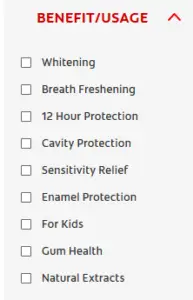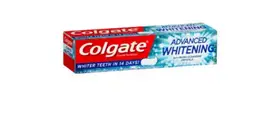Contents
What is Benefit Segmentation?
As implied by the name, benefit segmentation is splitting up the market based upon the key benefits and needs sought by purchasing consumers. As a result, benefit segmentation is a very consumer-centric approach as it identifies the core product needs of the consumers.
Note for students: in some marketing textbooks, benefit segmentation is included as a segmentation variable under the major segmentation base of behavioral segmentation, but a number of marketing takes include it under its own heading. This means that there may be four or five main consumer segmentation bases, depending upon the textbook you are utilizing.
Consumers look for sets of benefits
It is important to note that consumers will look at the overall offering of a brand and consider its value proposition = full set of benefits.
Therefore, it is important that brands offer an array of benefits to meet consumer needs and to defend against competitor offerings. While offering these benefits, they will still promote a strong and clear positioning on one or two of those benefits, in order to stand out in the marketplace and be chosen by at least some consumers as the best product for them.
By careful design of product attributes, it is possible to construct different products that will have appeal across different benefit segments. This is an effective approach to reducing the threat of competitor offerings, as well as strengthening retailer and channel relationships.
This is discussed elsewhere on the Market Segmentation Study Guide website, outlining the differences between points-of-difference and points-of-parity.
Profiling benefit segments
In addition to segmenting on the benefits sought by each group of consumers, these segments can then be profiled and described by adding demographic information and some behavioral variables, such as brand attitudes and level of consumption. This means that in addition to their core needs, we can develop a deeper understanding of the consumers within that segment.
Benefit segments and positioning
Using benefit segmentation is advantageous to deciding on product positioning. As we will know the core benefit/need being sought from the design of the segments themselves, it becomes quite clear as to how to effectively position the product for success in the marketplace.
Indeed, if there is a cluttered market with multiple similar positionings on offer, then creating additional (smaller) benefit segments will help identify new positioning opportunities.
Benefit segmentation example 1: Shampoo
Using benefit segmentation to position products in the shampoo market is a powerful strategy, given the diverse needs of consumers in this category. Each segment is defined by a specific core benefit sought by consumers, making it easier to design products, tailor marketing efforts, and differentiate from competitors.
Core Benefit Segments in the Shampoo Market
- Hair Repair:
- Target Consumers: Individuals with damaged or brittle hair caused by heat styling, chemical treatments, or environmental factors.
- Positioning: “Nourishment and repair for stronger, healthier hair.”
- Example: L’Oréal Elvive Total Repair 5, positioned as a solution for damage control and restorative care.
- Dandruff Control:
- Target Consumers: Those struggling with flaky, itchy scalp issues.
- Positioning: “Clinically proven to reduce dandruff and soothe the scalp.”
- Example: Head & Shoulders Classic Clean, emphasizing its dermatologist-recommended formula for dandruff relief.
- Volume Boosting:
- Target Consumers: Consumers with fine or flat hair seeking fuller, more voluminous styles.
- Positioning: “Transforms limp hair into full-bodied locks.”
- Example: Pantene Pro-V Volume Shampoo, highlighting lightweight formulas that add lift and body.
- Color Protection:
- Target Consumers: People with dyed or highlighted hair who want to maintain their color vibrancy.
- Positioning: “Locks in color and prevents fading for up to 8 weeks.”
- Example: Redken Color Extend, promoting UV protection and sulfate-free formulations to preserve color.
- Scalp Care:
- Target Consumers: Those experiencing dryness or oil imbalance on the scalp.
- Positioning: “Rebalancing formula for a healthy, refreshed scalp.”
- Example: Neutrogena T/Gel, marketed as a therapeutic shampoo addressing scalp health concerns.
- Natural Ingredients:
- Target Consumers: Eco-conscious consumers prioritizing sustainable, chemical-free products.
- Positioning: “Plant-powered, sulfate-free care for your hair.”
- Example: Aveda Rosemary Mint Shampoo, emphasizing organic ingredients and environmentally friendly practices.
Marketing Mix for Benefit Segmentation
- Product Design:
- The product formulation, fragrance, and texture are tailored to the specific benefit segment. For instance, a hair repair shampoo would include keratin or protein-based ingredients, while a natural shampoo would avoid sulfates and parabens.
- Pricing:
- Pricing often reflects the perceived value of the benefit. Premium segments like color protection or natural ingredients command higher prices, while dandruff or scalp care shampoos cater to broader affordability.
- Packaging:
- Packaging highlights the core benefit prominently. For example:
- Hair Repair: Visuals of glossy, healthy strands and ingredients like keratin.
- Natural Ingredients: Earthy tones, images of plants, and eco-friendly symbols.
- Volume Boosting: Words like “lift” and “lightweight” alongside bold, attention-grabbing colors.
- Packaging highlights the core benefit prominently. For example:
- Promotion:
- Campaigns center on the benefit. A color protection shampoo may feature testimonials from hair colorists or vibrant before-and-after shots, while a dandruff shampoo would highlight clinical trials and dermatologist endorsements.
- Placement:
- Products are distributed to align with the target audience:
- High-end salons for premium products like color protection.
- Mass retailers for everyday needs like dandruff or volume-boosting shampoos.
- Specialty organic stores or e-commerce for natural shampoos.
- Products are distributed to align with the target audience:
Benefit segmentation example 2: Gyms and Fitness Centers
Benefit segmentation can be equally powerful in services markets, such as gym memberships, where consumers seek a variety of outcomes based on their specific fitness goals, lifestyle preferences, and motivations. By identifying and targeting distinct benefit segments, gyms can position their services to meet these diverse needs effectively.
Core Benefit Segments in the Gym Membership Market
Weight Loss and General Fitness
- Target Consumers: Individuals seeking to lose weight or maintain a healthy lifestyle.
- Positioning: “Achieve your fitness goals with our beginner-friendly equipment and tailored weight loss programs.”
- Example: Gyms like Anytime Fitness emphasize accessibility, simplicity, and supportive environments for those new to fitness.
Strength and Performance Training
- Target Consumers: Athletes, bodybuilders, or fitness enthusiasts focused on building strength and improving performance.
- Positioning: “Unleash your potential with our cutting-edge strength training equipment and advanced facilities.”
- Example: Gold’s Gym positions itself as a go-to destination for serious fitness enthusiasts, highlighting its comprehensive weightlifting resources and expert trainers.
Group Fitness and Social Engagement
- Target Consumers: Those who enjoy the social aspect of working out and find motivation in group settings.
- Positioning: “Stay motivated and connected with dynamic group classes led by expert instructors.”
- Example: Gyms like F45 and Orangetheory Fitness focus on high-energy, instructor-led group workouts to foster community and shared goals.
Convenience and Accessibility
- Target Consumers: Busy professionals or individuals looking for flexible workout options.
- Positioning: “24/7 access to state-of-the-art facilities—fitness that fits your schedule.”
- Example: Planet Fitness and Snap Fitness target convenience-seekers by offering extended hours and low-cost membership options.
Holistic Wellness and Mindfulness
- Target Consumers: Individuals prioritizing mental well-being alongside physical fitness.
- Positioning: “Rejuvenate your mind and body with yoga, meditation, and wellness classes.”
- Example: Premium gyms like Equinox position themselves as holistic wellness centers, integrating spa-like amenities with fitness.
Family-Friendly Facilities
- Target Consumers: Parents looking for fitness solutions that accommodate family needs.
- Positioning: “Fitness for the whole family, with kid-friendly spaces and programs.”
- Example: YMCA appeals to families by offering childcare services, youth programs, and family-oriented memberships.
Marketing Mix for Benefit Segmentation in Gyms
Service Design
Each segment requires tailored services to deliver the desired benefit. For instance:
- Weight loss programs might include personal trainers and nutrition counseling.
- Group fitness enthusiasts benefit from a wide variety of classes like Zumba, spin, or HIIT.
- Family-oriented gyms could offer childcare and activities like swimming lessons for kids.
Pricing
Pricing strategies align with the perceived value of the benefit:
- Affordable Memberships: Budget gyms targeting general fitness (e.g., Planet Fitness) may offer low-cost memberships.
- Premium Pricing: Wellness-oriented gyms (e.g., Equinox) charge higher fees, reflecting their spa-like facilities and luxury services.
Promotion
Promotional efforts emphasize the core benefit of each segment:
- Weight loss campaigns may showcase testimonials, before-and-after transformations, and free trial sessions.
- Strength training promotions could feature endorsements from professional athletes or trainers.
- Group fitness ads often highlight the energy, fun, and community vibe of classes.
Placement
The location of gym facilities and services plays a significant role:
- Convenience-focused gyms prioritize accessibility, with multiple locations and flexible hours.
- Wellness-oriented gyms may choose upscale neighborhoods to attract premium members.
People
The people involved in delivering gym services, from trainers to customer support staff, play a critical role in shaping the customer experience.
- Personal Trainers and Staff Expertise:
- Highly skilled and certified trainers can significantly influence member satisfaction and retention. For instance, gyms offering specialized trainers (e.g., strength coaches, yoga instructors) can attract members seeking expert guidance.
- Staff should be approachable and motivational, creating a welcoming environment for members of all fitness levels.
- Customer Service:
- Front-desk staff and support teams should provide seamless service, assisting with membership queries, booking classes, and addressing concerns promptly.
- Personal touches, like remembering a member’s name or goals, enhance the gym’s reputation and encourage loyalty.
- Community Building:
- Group fitness instructors foster a sense of community and camaraderie among members.
- Hosting member events, challenges, or social activities encourages engagement and positions the gym as more than just a workout space.
Process
The processes involved in delivering gym services should be efficient, user-friendly, and designed to enhance the overall customer experience.
- Membership Onboarding:
- A streamlined sign-up process, with clear communication of terms and benefits, ensures a positive first impression.
- Offering a free trial period or a personal orientation session helps new members feel comfortable.
- Class Booking Systems:
- Gyms should invest in robust digital platforms that allow members to book classes, track attendance, and manage their schedules easily.
- Notifications for upcoming classes or cancellations improve reliability and member satisfaction.
- Fitness Tracking and Goal Management:
- Providing tools or apps to track progress—such as calories burned, weight lifted, or goals achieved—keeps members motivated and engaged.
- Regular progress reviews with trainers offer personalized feedback and reinforce the gym’s commitment to results.
- Operational Efficiency:
- Minimizing wait times for equipment or services through proper scheduling and capacity management ensures a smooth experience, even during peak hours.
- Maintaining clean and operational facilities reflects well on the gym’s professionalism.
Physical Evidence
As a tangible representation of the gym’s brand and quality, physical evidence reinforces trust and delivers a consistent experience.
- Facility Design and Layout:
- Modern, clean, and well-maintained facilities create a positive impression. A logical layout, with clearly defined zones for cardio, strength training, group classes, and relaxation, ensures convenience and accessibility.
- Ambiance:
- Elements like lighting, music, and interior design contribute to the atmosphere. For example:
- High-energy music and bold lighting for performance zones.
- Calm, soothing environments in yoga and wellness areas.
- Elements like lighting, music, and interior design contribute to the atmosphere. For example:
- Branded Materials:
- Consistent branding across gym signage, member cards, workout gear, and promotional materials reinforces the gym’s identity.
- Offering branded merchandise, such as water bottles or gym bags, strengthens the gym’s presence outside its walls.
- Digital Presence:
- The gym’s app, website, and social media platforms act as extensions of its physical evidence. A user-friendly interface, engaging content, and clear communication build trust and make the service more accessible.
- Virtual tours and testimonials showcased online help potential members visualize the experience before visiting.
Strategic Advantages of Benefit Segmentation for Gyms
- Targeted Offerings: Each segment receives services tailored to their specific needs, increasing satisfaction and retention.
- Market Differentiation: Benefit-based positioning creates distinct value propositions, allowing gyms to stand out in a crowded market.
- Customer Loyalty: Meeting specific fitness goals fosters emotional connections and long-term memberships.
- Multi-Segment Offerings: Gyms can serve multiple segments without cannibalization by clearly defining each offering, such as separate areas for strength training, group fitness, and family activities.
Benefit segmentation example 3: Colgate
 The classic example for benefit segmentation toothpaste market, where most of the product offerings are targeted at benefit segments. For example, you can buy toothpaste for:
The classic example for benefit segmentation toothpaste market, where most of the product offerings are targeted at benefit segments. For example, you can buy toothpaste for:
- Fresh breath
- Teeth whitening
- Cavity protection
- Sensitive teeth
- And so on
Even the Colgate website uses the word benefit when outlining their choice of products, as shown in the above image.
Benefit segmentation and the marketing mix
As discussed above, the positioning of the product becomes quite clear if you are targeting a specific benefit, as the product will have to be clearly positioned to meet that need.
Here are two examples for Colgate, the first product is positioned around “advanced whitening” and the second is positioned around “advanced whitening for sensitive teeth”.
In terms of pricing, both of these product offerings would be expected too have a price premium over standard toothpaste products. And in terms of packaging information and any promotional materials, the emphasis would be built around the core benefit = positioning.
You should also note from above two examples, that firms like Colgate seek to use benefit segmentation as an aggressive competitive strategy, by eliminating potential gaps in the marketplace that their competitors could seek to leverage.
Advantages and limitations of benefit segmentation
Benefit segmentation is an effective strategic approach for cluttering the market, which would reduce the threat of new competitive products, as there are less obvious product gaps.
This is especially true if the product/brand becomes well-known by consumers for providing that specific benefit. That essentially forces competitors to compete in another benefit segment space.
Benefit segmentation also targets existing consumer needs, rather than trying to modify consumer behavior.
It is a somewhat simpler marketing approach, as it relies upon a rational purchase for a specific benefit, rather than trying to build a strong emotional connection to a brand or product offering
Benefit segmentation allows a company to introduce multiple products into the same product category, but are able to reduce the risk of product cannibalization because each product has a clearly defined benefit, and therefore a defined target market.
| Advantages of Benefit Segmentation | Limitations of Benefit Segmentation |
|---|---|
| Reduces competition by occupying distinct market spaces, minimizing obvious product gaps. | Requires extensive research to identify and understand benefit segments, which can be costly and time-consuming. |
| Builds a strong reputation for meeting specific consumer needs, forcing competitors to seek alternative benefits. | May overlook emotional or experiential elements that influence consumer decisions, especially in highly competitive markets. |
| Targets pre-existing consumer demands, aligning products with clear motivations and reducing the need to alter behavior. | Segments can overlap, leading to potential confusion in positioning or diluted messaging. |
| Simplifies the marketing approach by focusing on rational benefits instead of emotional connections. | Focusing on a narrow benefit could alienate broader audiences who seek multiple benefits from a single product. |
| Enables companies to launch multiple products in the same category while minimizing cannibalization through clear benefit differentiation. | Market changes or evolving consumer preferences can render specific benefit segments obsolete over time. |
A generic approach to benefit segmentation
Related Articles
- Behavioral segmentation
- Demographic segmentation
- Psychographic segmentation
- Choice of consumer segment bases
- Choice of business segment bases
Academic Readings


